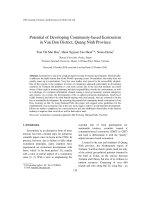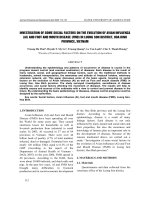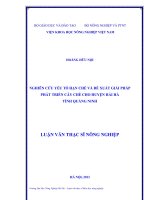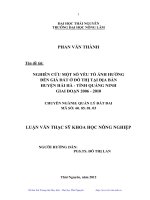Plant diversity and structure of mangroves in hai ha district quang ninh province
Bạn đang xem bản rút gọn của tài liệu. Xem và tải ngay bản đầy đủ của tài liệu tại đây (11.04 MB, 74 trang )
ACKNOWLEDGEMENT
First and foremost, I would like to express my sincere gratitude to my advisor Assoc.
Prof. Dr. Vu Quang Nam for the continuous support of my student thesis study and research,
for his motivation, enthusiasm, and immense knowledge. His guidance helped me in all the
time of research and writing of this thesis.
Beside my advisor, I would like to thank professor from Colorado State University,
Dr. Lee Macdonald, for his guidance, patience, and providing my class with an excellent
atmosphere for our research. My sincere thanks also goes to Mr. Nguyen Van Hieu- viceleader of mangrove forest protection, who provided me many useful knowledge about
mangrove forest and all of officers in Hai Ha district, for their giving information about the
local area and culture that helped me a lot in this study.
Lastly, I would like to thank to my family: my father who always support to me and
my friends who helped me in my research.
1
ABSTRACT
Mangrove at Hai Ha district constitutes a mangrove flora that contributes to the
biodiversity in the coastal region. This research concentrates on three objectives: descriptive
the biodiversity species and role of mangroves forest in Hai Ha district; determine species
composition, structure and distribution of the mangrove flora in Hai Ha district; proposed
some solutions to protect and develop sustainable mangrove forest.
To conduct these objectives above, the research established 6 survey lines is
perpendicular with the sea dike and set up 18 standard plots for six communes in Hai Ha
District, each plot has area with 400 m2 (20x 20m) along the transect line.
From the results collected, I constructed the list of vascular plants including 41 species
belonging to 26 genera, 10 main mangrove species and 31 species living in mangrove forest.
They distribute in 5 main regions: regular intertidal zone; irregular intertidal zone; sands
sludge formation and improvements; improvement sand area less tidal and coastal shrimp
farms, road and sea dike. There are three communities in study site: Avicennia marina Rhirophora stylosa - Aegiceras corniculatum (Am - Rs - Ac), Aegiceras corniculatum Bruguiera gymnorrhiza - Rhirophora stylosa (Ac - Bg - Rs) and Aegiceras corniculatum Avicennia marina - Rhirophora stylosa (Ac - Am - Rs). Over time, mangrove succession have
trend to the sea and we need some solutions to protect and develop sustainable mangrove
forest in Hai Ha district.
2
TABLE OF CONTENTS
CHAPTER I. INTRODUCTION............................................................................................ 1
CHAPTER II. LITERATURE REVIEW ................................................................................ 4
2.1. Mangrove forest in the world........................................................................................... 4
2.2. Mangrove forests in Vietnam: ......................................................................................... 6
CHAPTER III. STUDY GOAL, OBJECTIVES, SCOPE OF THE STUDY AND
METHODOLOGY ................................................................................................................ 9
3.1.1. Goals: Assessment of biodiversity and structure of coastal mangrove forests, which
proposed several solutions to contribute to better management of coastal mangroves. ............ 9
3.1.2. Specific Objectives: ...................................................................................................... 9
3.2. SCOPE OF THE STUDY................................................................................................ 9
3.2.1. Geographical location, topography ............................................................................... 9
3.2.2. Climate: ..................................................................................................................... 10
3.2.3. Hydrology: ................................................................................................................. 11
3.2.4. Salinity: ...................................................................................................................... 12
3.2.5. Soil conditions: .......................................................................................................... 12
3.3. CONTENTS AND METHODOLOGY ......................................................................... 14
3.3.1. Research Content ....................................................................................................... 14
3.3.2. Methodology .............................................................................................................. 14
3.3.2.1. Data collection method: ........................................................................................... 14
CHAPTER IV. RESULTS AND DISCUSSION .................................................................. 19
4.1. DIVERSITY OF MANGROVE FORESTS IN COASTAL AREA HAI HA DISTRICT,
QUANG NINH PROVINCE ................................................................................................ 19
4.1.1.
List of mangroves in the study area ........................................................................ 19
4.1.2. Value of mangrove forest ........................................................................................... 27
3
4.2.
DISTRIBUTION AND STRUCTURE OF MANGROVE FORST IN COASTAL
AREA HAI HA DISTRICT, QUANG NINH PROVINCE ................................................... 33
4.2.1. Characteristic and distribution of mangrove forest in Hai Ha district .......................... 33
4.2.2. Combination of species .............................................................................................. 35
4.2.3. Species density ........................................................................................................... 40
4.2.4. Stratified structure ...................................................................................................... 41
4.3.
PROPOSING SOME SOLUTIONS TO USE SENSIBLY, PROTECT AND
DEVELOP HAI HA MANGROVE FOREST ...................................................................... 45
4.3.1. Status of mangrove forest in Hai Ha district................................................................ 45
4.3.2. Proposing some solutions to use, protect and develop Hai Ha Mangrove forest .......... 45
CHAPTER V. GENERAL CONCLUSION AND RECOMMENDATION .......................... 50
5.1. Conclusion .................................................................................................................... 50
5.2. Recommendation .......................................................................................................... 50
REFERENCES .................................................................................................................... 50
APPENDIX ......................................................................................................................... 52
4
LIST OF TABLES
Table 3.1: The area of tidal ground has salt-marsh vegetation in Hai Ha district. .................. 13
Table 4.1. List of mangroves in 6 coastal communes in Hai Ha district, Quang Ninh province. ..... 19
Table 4.2. Numbers of species in phyla and classes found in Hai Ha mangrove forest. ................. 23
Table 4.3. Life forms of mangrove plants in Hai Ha district, Quang ninh provice. ................ 26
Table 4.4. Values of mangrove species in Hai Ha district. .................................................... 30
Table 4.5. Groups of valuable plants in Hai Ha mangrove forest. ......................................... 32
Table 4.6. Composition of mangrove strata follows to plots ................................................. 35
Table 4.7. Mangrove communities in 6 strata ....................................................................... 36
Table 4.8. Tree density of mangrove communities in Hai Ha District ................................... 40
Table 4.9. Awareness of coastal people about roles of mangrove forest ................................ 46
Table 4.10.Awareness of secondary students about roles of mangrove forest........................ 46
Table 4.11. Coastal people’s knowledge about roles of mangrove forest .............................. 47
Table 4.12. Hai Ha student’s knowledge about roles of mangrove forest .............................. 47
5
LIST OF FIGURES
Figure 2.1: Global mangrove forests distribution 2000 (Giri et al., 2011). Map redrawn by
UNEP/DEWA. Red lines/areas indicated to mangrove forest. ................................................ 4
Figure 3.1: Research sites ..................................................................................................... 13
Figure 3.1: Standard plots are set up on survey line .............................................................. 15
Figure 3.2: Plot establishment .............................................................................................. 16
Figure 4.1: Vertical profile in line 1+2 ................................................................................. 42
Figure 4.2: Cross profile in line 1+2 ..................................................................................... 42
Figure 4.3: Vertical profile in line 3 ..................................................................................... 43
Figure 4.4: Cross profile in line 3 ......................................................................................... 43
Figure 4.5: Vertical profile in line 4+5+6 ............................................................................. 44
Figure 4.6: Cross profile in line 4+5+6 ................................................................................. 44
Chart 4.1. Percentage of species found in Hai Ha mangrove forest. ...................................... 24
Chart 4.2. Awareness of coastal people and secondary students about roles of mangrove forest..... 46
Chart 4.3. Knowledge about roles of mangrove forest of coastal people and secondary student
in Hai Ha district. ................................................................................................................. 47
6
CHAPTER I. INTRODUCTION
Located between sea and mainland, mangrove forests are the specially ecosystem of
tropical and subtropical sea but they are sensitive with the human impact. Flora and fauna in
this forest have special biological characteristics to adapt with muddy, frequently saltwater
environments.
The existence of mangrove forests have the important meaning for environment and
socioeconomic, mangrove forests not only provide valuable forest products such as: timbers,
coals, woods, tannins, foods, medicines, etc. but also be the detritus source to raise the local
aquatic species or the species that live in estuaries and adjacent coastal. Mangrove forest is
the wintering habitats of migratory birds and nesting place of waterfowls (Phan Nguyen
Hong, 1991) [12]. Mangrove forests play important role in protecting environment,
controlling climate, preventing storm, expanding the area of the continent, preventing inland
encroachment of saltwater. They also supply foods for raising livestock’s and breeding bees.
Mangrove forests help the poor coastal people to improve their life. They also are the
attractive ecotourism location for domestic and foreign tourists, researching and studying
places of students and scientists about mangrove ecosystems. However, Vietnam mangrove
vegetation has being seriously degraded because of consequents of wars. After wars, due to
poor conditions of economy, population explosion, low awareness of resident, people exploit
indiscriminately mangrove forest for materials, destroy forest to grab land for agriculture,
shrimp farms, salt fields. These activities make the mangrove forest areas reduce, soil degrade
seriously, thousands of hectares of forest land be abandoned and not restored, biodiversity
resources and fishery resources of coastal areas be impaired and environment be polluted.
Recognizing the importance of mangrove forests, especially from the consequences of
natural disaster in the coastal areas that lost mangrove forest, the mangrove ecosystem
planting and restoring movement has being flourished in coastal areas across the country such
1
as program 327, Growing 5 million hectares forest program, and also some international
organizations (PAM) and non-governmental organizations (SCF UK, ACTMANG, Red Cross
of Danish and Japan, etc.) cooperate with Mangrove ecosystems research centers.
Hai Ha district is a border and island mountainous district, this place has 35 kilometers
coastline and 8000 hectares total area of intertidal, in which 1/3 area is mangrove forest, 1/3 is
aquaculture area and the rest is unused mudflats estuarine. The natural mangrove forests have
important role to the development of economy such as protecting dykes and shrimp ponds,
improving environment and being the habitat of aquatic species with high economic value like
mangrove mud clam (LUCINA philippinarum), vạng (Geloina coason), sá sùng (Sipunculus
nudus), bông thùa (Phascolosoma arcuatum). Mangrove forests are also the place to nourish
shrimps and crabs parents, abode of the baby sea animals. Nevertheless, the mangrove
deforestation situation for taking materials, especially deforestation for shrimp farming is
occurring seriously. This situation make mangrove forest areas substantial decline, up to now,
only in Quang Phong commune, 90/420.36 hectares have cleared (according to the Hai Ha
forestry department, 2004)[6]. Besides that, after being cleared, the regeneration of flora of
the natural mangrove forest is impoverished, mostly is the species of Avicenniaceae (Mắm
families) that grow purely or grow intersperse with Aegiceras corniculatum L. Blanco (Sú).
These species belong to the dust type, branches close to the ground, monotonous and less
floor forest, trees grow slowly and canopy slowly closed. To overcome this phenomenon,
there are some needed appropriate solutions as planning shrimp yard, growing more
mangrove trees that have large size like Rhizophora stylosa Giff (Đước Vòi) … Moreover,
researching to growing other addition trees that accordance with the living conditions of each
region is necessary to raise the biological diversity and give back green color for Hai Ha
mangrove forest. Along with reforestation, the development and protection of mangroves
should be more concerned. Start from these reasons, in order to plant, take care of, protect and
2
develop mangrove forest effectively, the basic knowledge about biological classification,
function as well as species composition, distribution and regeneration of the region's
mangrove species is very necessary and important. Although there have been many studying
documents about mangrove forest but Hai Ha district still not have a research projects in
species composition, distribution, biological diversity and structure of mangroves in local.
And thus, from these reasons, I would like to proceed with the topic: "PLANT DIVERSITY
AND STRUCTURE OF MANGROVES IN HAI HA DISTRICT, QUANG NINH
PROVINCE".
3
CHAPTER II. LITERATURE REVIEW
2.1. Mangrove forest in the world
Mangrove forests distribute mainly on the equator and 2 sides tropical hemisphere.
However, some species expand up to 32o22’North (Bermuda) such as: Rhizophora stylosa,
Kandelia candel, and Bruguiera gymnorrhiza (Le Van Hien, 2005).
The limit of mangrove trees in South is New Zealand (38 o03’South latitude) and the
South of Australia (38 o43’South latitude). In those areas, the species that can survive is
Avicennia marina due to the cold winter.
Figure 2.1: Global mangrove forests distribution 2000 (Giri et al., 2011). Map redrawn
by UNEP/DEWA. Red lines/areas indicated to mangrove forest.
Following to the evaluation of Hutchings and Seanger (1987), mangrove area in the
world is 15,492,000 ha. There are 6,246,000 ha belong to tropical Asian region and Oceania,
5.781.000 ha belong to America regions, and 3,402,000 ha of tropical Africa (Nguyen Hoang
Tri, 1999).
According to Wash (1974), the distribution of mangrove forests in the world are
divided two main regions (Hoang Van Thoi, 2005).
-
India-Pacific areas: including Southern Japan, Southeast Asia, India, the Red Sea
coast, East Africa, Australia, New Zealand, the South Pacific Island, and Xamoa archipelago.
4
-
West Africa-Americas areas: covering the coast of Africa in the Atlantic Ocean,
the Galapagos Islands, and the Americas.
According to some other authors, the area between Malaysia and northern Australia is
the main distribution of mangrove flora. However, based on analyzing fossils, some authors
said that this center is located in the southwestern and northern Australia to Papua New
Guinea rather than Malaysia. In Australia and Papua New Guinea have about 30 species of
trees and shrubs belong to 14 families; moreover, mangrove forest also has 10 species belong
to 8 lianas, a large number of different plant species like algae, fungi, lichen, Ipomoea pescaprae also found in mangroves communities, but most species can live in many other
communities not only in mangrove communities..
There are many research on mangrove forest in the world. P.V.Richard has many
studies in areas of South America, Central Africa, and Southeast Asia. Especially, he has
researched about “Tropical rainforest”. In this study, the authors have studied landforms,
structures, components, and natural conditions (soil, climate ...) of the tropical rain forest,
including mangroves.
After many experiments, observation about dispersal and regeneration of some
mangrove species in Panama, Rabinowitz (1975) said that the number of young dominant
mangrove species in low tide is bigger than in highland and need the time for scattering and
fixing trees. He also thinks that the mortality of propagulesis inversely proportional to their
masses. When the seedlings have fixed and started growth, they usually grow poorly below
the shade of tall trees (Nguyen Thi Thuy Huong, 2006).
Kasawani et al (2007) studied about for forest structure, diversity index, and biomass
of forest mangrove in Tok Bali, Kenlanta, Malaysia. The authors tried to find out the structure
of mangrove distribution to establish the recover and management program. The result shows
that Sonneratia alba is dominant species with more than 73 trees in each transect line.
5
Suwa et al (2009) researched the structure of a subtropical mangrove forest along
Okukubi River in Okinawa Island, Japan base on biomass and tree height. The research shows
that the reduction of biomass and tree height does not necessarily reflect the leaf
photosynthesis and development of mangrove trees.
2.2. Mangrove forests in Vietnam:
Vietnam is located in tropical climate with advantages for mangrove forest
development. Before 1943, there are about 400,000 ha of mangrove forest areas in Vietnam,
but till 1975, only left 185,877 ha due to many different reasons such as war, mining, and
unsustainable management of mangrove forests.
Phan Nguyen Hong (1999) published the plant species composition of Vietnam’s
mangrove ecosystems includes 77 mangrove species of 2 environmental groups, and various
life forms. Group I has 35 mangrove species belong to 20 genera of 16 families, this group is
often called the "true" mangrove group. Group II consists of 42 species belong to 36 genera of
16 families, this group includes "join" species in the mangroves and they often live in
secondary forest and highland. Phan Nguyen Hong also was the first man in Vietnam to
mention about the geographical distribution and mangrove community’s succession in many
researches. Inour country’s mangrove ecosystem, there are 45 mangrove forest communities,
6 mangrove forest populations distributed in different regions.
In recent years, Vietnam has many researches about mangrove forest. Vu D.T et al
(2003) studied mangrove forest in 3 different ages at Giao Lac, Giao Thuy, and Nam Dinh.
He thinks that Kandelia forest in ages from 4 to 6, and planted in distance of 0.7 x 0.7m have
better tree diameter and height.
Dao.V.T et al (2005) investigated some characteristics of mangrove plant communities
in Dien Chau, Nghe An. He listed a total of 40 species belong to 37 genera of 24 vascular
families distributed in the mangroves at study area. The research has also mentioned about
6
some species participate in mangrove forest composition in Dien Chau, and divided them into
8 typical species communities with high value in the study area.
Hoang V.T (2005) studied mangroves structure and the relationship between
mangrove vegetative distribution and frequent tidal mangrove forest in Ca Mau to conclude
that: the study area has 12 states of mangrove forest with 72 species belong to 40 families.
True mangroves group includes 23 species belong to 12 families; the tree participation group
includes 49 species belong to 28 families. Sonneratia alba and Avicennia officinalisare
dominant tree species, and Rhizophoraforest is the largest area.
Based on geographical factors, fieldwork and part of results Remote Sensing,
P.N.Hong (1991, 1993) were divided into 4 Vietnam mangrove areas and 12 sub-zones:
Zone I: Northeast in the Coastal, from Mui Ngoc to Do Son.
Zone II: North Delta in the Coastal, from Do Son to Lach Truong.
Zone III: Central Vietnam in the Coastal, from Lach Truong to Vung Tau.
Zone IV: Southern in the Coastal, from Vung Tau to Mui Nai - Ha Tien.
Zone I: Mangroves grown by the outer shielding island, the species mainly
Rhizophora stylosa, Kandelia obovata, Bruguiera gymnorrhiza (L), Aegiceras corniculatum
(L) Blanco, Avicennia marina. Due to the air temperature in the winter cold, so the tree is
small in size, only a height of about 1.5 to 7 m.
Zone II: Despite the extensive alluvial, alluvial-rich, but here empty beach, no
shielding storm islands, only a few mangrove estuaries in the main tree species such as
Sonneratia L. , Kandelia obovata, Aegiceras corniculatum (L) Blanco, Acanthaceae. Sonneratia
L. relatively large size, 8-12 m tall, 15-20 cm in diameter.
Zone III: Mudflats narrow, less silt coast by steep, windy storm, forests of narrow
strip just inside the estuary. The trees are mostly plants: Rhizophoracaea, Bruguiera
7
gymnorrhiza (L.), Aegiceras corniculatum (L.) Blanco, Avicennia marina, often small trees,
the branches more.
Zone IV: There are extensive mudflats, numerous sediment by the Dong Nai river
system and the Mekong River system provides less wind storm so well developed mangroves,
especially Ca Mau peninsula. The forest has many species of trees, with a high diversity and
large size.
According to this division, the Hai Ha district in zone I and brought many common
traits of this region but also the peculiarities of the terrain leading to mangrove vegetation has
many distinctive features will be outlined in the next part.
8
CHAPTER III. STUDY GOAL, OBJECTIVES, SCOPE OF THE STUDY AND
METHODOLOGY
3.1. STUDY GOAL, OBJECTIVES
3.1.1. Goals: Assessment of biodiversity and structure of coastal mangrove forests, which
proposed several solutions to contribute to better management of coastal mangroves.
3.1.2. Specific Objectives:
Objective 1: Investigate the biodiversity of coastal mangrove (species diversity of
coastal mangrove) in Hai Ha districts, Quang Ninh province.
Objective 2: Investigate the distribution and structure of coastal mangroves in Hai Ha
districts, Quang Ninh province.
Objective 3: Propose possible solutions for sustainable mangrove management in
study areas.
3.2. SCOPE OF THE STUDY
3.2.1. Geographical location, topography
Hai Ha is a district of mountainous, border and island are 150 km far from Ha Long
city to the north, 40 km far from Mong Cai international border gate. Bordering China to the
north, the border line are 22.8 km, Bordering East Sea to the south, coastline measure is 35
km, the west by Binh Lieu and Dam Ha, thw east by Mong cai town
Geographical coordinates:
210 12’ 46’’ - 1070 38’ 27’’ north latitude
1070 30’ 54’’ - 107 051’ 49’’ east longitude
The topography of the district is generally slope and strong intersect with many rivers
and estuaries as Ma Ham, Ha Coi, polo, Duong Hoa and Cai Da Ban. outboard of sea is
covered by 2 rows of the island is The Lamb and Vinh Thuc creates a tight bay, has a low
tidal systems and extensive development.
9
3.2.2. Climate:
Like other districts of Quang Ninh province, Hai Ha district with climate regime
tropical monsoon nature. Hai Ha is a coastal mountainous district, the climate has moderate
mountainous nature of the coastal nature, cold winter with temperatures down to 5-6 0C, often
with hoarfrost.
Temperature regime:
Temperature regime depends on internal tropical radiation changes over the tropics
and monsoon. The annual average temperature is about 22.7 0C, the average amplitude of
oscillation in months from 15 - 30 0C, the highest temperature in July is 31.2 0C. Because the
highest amplitude of a temperature affects the growth of plants, some species of mangroves in
the South are not present here, the dimension of tree is smaller than the tree in the South
The total of radiation is an important factor in the formation of climate, decisions of
living and development of plants and planktons. The total of average radiation of 200 kcal /
cm2 / year, the highest in July is 286 kcal / cm2 (According to 2007 figures, Ho Thi Phuong,
meteorological stations in Hai Ha district).
Therefore, compared to Nam Dinh province which has an annual average temperature
is 24,30C (The center of National Hydro-meteorological 2006 - 2007), Hai Ha district has an
annual average temperature lower than 1,60C.
Wind regime:
Formation of two monsoons are the northeast monsoon (April 10-3) and the southwest
monsoon (June 4-8). The average wind speed was 2.5 m/s and reaches to maximum of 4.5 m/s
in the storm. Each year has an average from 3 to 4 small big storms land on the coast.
Rain regime, humidity:
Distribution of dry and rainy seasons is clearly. The dry season lasts from November
to April the following year, accounting for 15-20 % of annual rainfall, the lowest rainfall is
10
9.3 mm in January and 11 mm in November. The rainy season lasts from May 5 to 10,
accounting for 80-85 % of annual rainfall. The month with the highest rainfall is a June (630.7
mm). The annual average rainfall is 2630.4 mm. The rainfall total of the first 6 months of the
year in 2008 is 1267.5 mm and 799.8 mm in June. The average humidity reaches from 85 to
90 %, the average wind speeds is 3m/s.
Because the large rainfall is created such a freshwater stream relatively rich which is
favorable for the growth of mangroves. However, the rainy season of Quang Ninh in general
and Hai Ha in particular does not coincide with seasonal fruit and germination. This has
affected directly to the development of mangroves forest.
3.2.3. Hydrology:
River systems are quite dense with a density 2 km/km2, the main river system is a Ha
Coi river and some small rivers flow direction Northwest - Southeast. Features of the river
here is small, short and steep, on the river has many waterfalls and rapids, upstream is broad
and downstream is narrow. Estuary is heavily influenced by the tides. The rivers in the district
are less concentrated water flow in the rainy season. The total amount of sediment and
suspended solids content is low.
The coastal area of Hai Ha district has 5 estuaries, in order of estuaries from north to south
are Ma Ham, Ha Coi, Polo, Duong Hoa and Cai Da Ban. The estuaries are funnel-shaped.
Tide: In a month there is an intensity water, the vibration amplitude of wave from 0.5
to 1m. This is also the area with the greatest height of tidal coastal range in Vietnam, can
reach to 4 - 5m. Wave regime depends on seasonal wind regimes and shape of regional
topography. However, due to coastal topography of coastal areas and estuaries is relatively
tight so it is less affected by waves of Gulf of Tonkin, the internal waves formed is relatively
weak, no more than 1 meter in a storm. This is also facilitates in the distribution and growth
of mangrove trees.
11
3.2.4. Salinity:
The highest salinity on winter is 30-31 ‰ because it is less rain on this period. Salinity
is lowest on summer with 10-15 ‰. In the estuary area flow into the bay, the lowest salinity is
possible down to 2-4 ‰. Salinity in Thai Binh is lower, in the flood season from 9-17 ‰ and
the dry season from 23-30 ‰. The salinity is relatively high to be suitable with the growth
and development of salt-tolerant species such as: Avicennia marina (Mắm), Aegiceras
corniculatum (Sú)…
3.2.5. Soil conditions:
The coastal intertidal area is divided into two components according to deposit
components below
- Quang Thanh community, Quang Thang community, Quang Minh community have
main deposit components of sand, sand mix with gravel and coarse grain composition.
- Quang Phong community, Tien Toi community, Duong Hoa community, intertidal
sediments is fine in components. In Duong Hoa community, intertidal sediments are main
clay powder so the flora in these communes is more developed and richer in species
composition compared to other communes.
Because of the different backgrounds led to the flora in these two regions are also
different, the flora in Quang Phong, Tien Toi, Duong Hoa communes is rich and more
developed in the Quang Thanh, Quang Thang Quang Minh communes. (Data on the "Draft
plan of aquaculture in Hai Ha District in period 2006 to 2010 '', 2005)) [6].
Hai Ha district has six coastal communes following the sections from north to south
respectively: Quang Thanh, Quang Thang, Quang Minh, Quang Phong, Duong Hoa, Tien Toi.
12
Figure 3.1: Research sites
The Red-crossed marks show research sites.
The total area of tidal ground which has salt-marsh vegetation of the district is 1046,
shown in the following table:
Table 3.1: The area of tidal ground has salt-marsh vegetation in Hai Ha district.
Community
Area (ha)
Quang
Quang
Quang
Quang
Đuong
Thanh
Thang
Minh
Phong
Hoa
78.86
78.13
243.98
696.79
176.16
Tien Toi
93.33
(According to the report "Current status of mangrove forests and forest land in Hai Ha
district on 2015'' of the Agriculture and Pisciculture department in Hai Ha district).
13
3.3. CONTENTS AND METHODOLOGY
3.3.1. Research Content
Objective 1: To investigate the biodiversity of coastal mangrove (species diversity of
coastal mangrove) in Hai Ha districs – Quang Ninh province.
-
Investigate and assess the diversity of species, communities of mangrove forests.
-
Determine of species composition and assess species diversity of mangroves.
Objective 2: To investigation on the status of distribution and structure of coastal
mangroves in Hai Ha districs – Quang Ninh province.
-
Research some of the ecological conditions in mangrove forests areas.
-
Research the status and distribution of mangrove forests in Hai Ha District -
Quang Ninh Province: Determine areas of mangrove forests, determine the area of
distribution and species composition of vegetation in the forest area.
-
Research the structures of mangroves: investigate and determine species
composition, structure mangroves in the study area.
Objective 3: This objective proposes possible solutions for sustainable mangrove
management in study areas.
-
Find out the impact of local people to mangroves.
-
Investigate and interview the manager to know the management mechanisms of
mangroves at the local.
-
Recovery solutions of mangroves area.
-
Sustainable management solutions associated with economic development.
-
Protection measures and sustainable development of mangroves.
3.3.2. Methodology
3.3.2.1. Data collection method:
+ Field work:
In each community I chose one typical area to establish survey lines following to
Aksornkoae and Kongsangchai (1987) and each survey line is perpendicular with the sea dike
14
(from the dike to sea). In each commune have mangrove forest, we set up by lines from the
dike to sea about 3 lines for 6 communes (Quang Thanh, Quang Phong, Quang Thang, Quang
Minh, Duong Hoa, Tien Toi).
Figure 3.1: Standard plots are set up on survey line
Set up standard plots on survey line:
On each survey line, I selected 3 typical locations in the study area and distance from dike to
sea is about 50m, 150m and 250m to set up 3 plots (Plot 01; Plot 02; Plot 03) and each plot has an
area with 400 m2 (20m x 20m), each big plot had 5 sub-plots (2m x 2m) 4 plots at the corners and
one plot at the center of plot. The plots are established by tape and right angle. Boundaries of plot
are defined by 4 wood stakes at 4 corner of each plot and after that I stretched a cord around 4 stakes
to recognize each plot. I set up about 18 plots in the study area.
15
Figure 3.2: Plot establishment
In each plant community I set up 3 plots and determined the species component, the
number of each species and total number of trees. The information was recorded:
+) Number of standard plots, the area of survey plots, and date of investigation,
investigator and distance to edge (m)…
+) Measure and classify wood trees, shrubs and grasses: note all of trees in plots
survey and take specimens of unknown trees to investigate. Measuring trees density
(trees/plot), tree height, canopy height, canopy diameter of all wood trees having D 1.3≥ 3cm
and location of trees in plots.
Profile diagram
Each line chooses one typical forest strip to draw. Area’s strip is 10m x 25m (25m is
length of plot paralleling seaside and 10m is depth). Profile diagram is drawn based on
method of Richards P.W and Davis T.A.W (1933- 1934).
Profile diagram is drawn on paper; it is conducted with measuring trees and drawn one
by one.
16
Standing profile: draw the near trees first and the far trees after, the trees in front are
drawn solid lines and the trees in behind are drawn disjointed lines.
Cross profile: draw tree canopy on all plot area, the highest trees are drawn solid lines
and shorter trees are drawn disjointed lines.
To draw profile diagram, we need to measure tree index as trees height, trees canopy
in 2 directions (South North- East West), coordinate trees (distance between stumps with 2
sides of plot) and shape of trees. Name of trees drawn on profile diagram should be noted on
tree canopy (note if name of trees abbreviate).
Take photograph and collect necessary specimens in investigation process in order
to analysis and assess scientific name.
Interview method, surveys households, local governments:
To assess the impacts of local people on the mangrove forest, we use interview
methods, interviewed by the questionnaire for the local people, local officers, households,
farmer, fisher,.. in the study area to find out about regulations, institutional resource
management.
Investigate, collected on the number and severity of exploitation of natural resources,
ecological characteristics of some species.
The type of management, exploitation and use of natural resources in the local as well
as the development orientation.
3.3.2.2. Data analysis methods:
Statistical table about components and species compositions (following to Nguyen
Nghia Thin, 2007).
Assessing scientific name: by the method of morphological comparisons between
specimens collected with documents related to plant such: Vegetation of Vietnam (Pham
17
Hoang Ho, 1999-2000), Forest tree name of Vietnam (Vu Van Dung, 1996), Plants in
mongroves of Vietnam (Nguyen Hoang Tri, 1996)...
Sort tree species in family order according to the classification system of Takhtajan (2009).
Determine assemblages and communities in the study area.
Analyze and evaluate the data obtained, compare with the published documents.
Species composition of mangrove: divide into 3 main groups: True mangrove species
(MS), Mangrove associated species (MAS) and Immigrating local species (ILS) (base on
dividing mangrove group of Nguyen Nghia Thin et al (2001).
Determine the distribution of mangrove vegetation following to 5 main groups: regular
intertidal zone, irregular intertidal zone, sands sludge formation and improvements,
improvement sand area less tidal and coastal shrimp farms, road and sea dike based on
separation of Phan Ke Loc and Nguyen Tien Hiep (1998).
Analyze data by excel 7.0 software
-
The tree compositions:
Determine coefficient composition of each species calculated by:
The coefficient composition
With:
K is coefficient composition
n is the number of individual species in the study area
N is total individual species in communities
From that give the composition formula of each.
-
Density:
⁄
=
With: N: is number of individual species or total individual species in standard plot;
S: is area of plot (m2).
18
CHAPTER IV. RESULTS AND DISCUSSION
4.1. DIVERSITY OF MANGROVE FORESTS IN COASTAL AREA HAI HA
DISTRICT, QUANG NINH PROVINCE
4.1.1. List of mangroves in the study area
After carrying out field research, collecting and analyzing samples depending on
materials and helps of some experts, we have the list of Species in 6 coastal communes of Hai
Ha district, Quang Ninh province as follow:
(Names of species are arranged in alphabetical order and according to Phylum;
Family; Latin name; respectively).
Table 4.1. List of mangroves in 6 coastal communes in Hai Ha district, Quang Ninh
province.
No.
Scientific Name
(Phylum/Family/Latin Name)
PHYL. PTERIDOPHYTA
1
Ráng biển
Acanthus ilicifolius L.
Fam3. Aizoaceae
4
5
Sesuvium porlulacastum
6
Habitat
Distribution
+
F
3,4
A
+
H
2,3,5,8
A
-
Su
3
QP,TT
-
W
3,4
QM, QTh
-
H
3
A
-
H
4,5
QM
Lớp Hai lá mầm
Họ Ơrơ
Ơrơ
Họ Rau đắng đất
Sam biển
Họ Na/ Mãng cầu
Annona glabra L.
Na biển
Fam 5. Apiaceae
Họ Hoa tán
Centella asiatica L .
Cây rau má
Plucchea pteropoda Hemsl
forms
Ngành Hạt kín
Fam 4.Annonaceae
Fam 6. Asteraceae
Life
Ngành Dương xỉ
Acrostichum aureum
Fam.2. Acanthaceae
Species
/Common Name)
Họ Chân xỉ
CLASS1.DICOTYLEDONEAE
3
(Phylum/Family
Fam.1 Pteridaceae
PHYL. ANGIOPSERMAE
2
Vietnamese Name
Họ Cúc
Sài hồ nam, cỏ lức
19
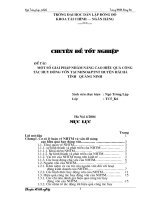
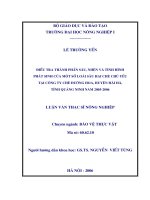
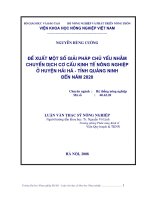
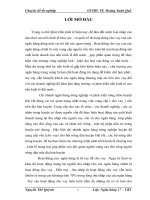
![[Luận văn]đánh giá thích hợp đất đai và đề xuất cơ cấu cây trồng huyện hải hà, tỉnh quảng ninh](https://media.store123doc.com/images/document/13/gu/po/medium_bGxLJRQVLE.jpg)
